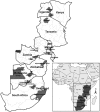Acceptability of male circumcision for prevention of HIV/AIDS in sub-Saharan Africa: a review
- PMID: 17053855
- PMCID: PMC1847541
- DOI: 10.1007/s10461-006-9169-4
Acceptability of male circumcision for prevention of HIV/AIDS in sub-Saharan Africa: a review
Abstract
Based on epidemiological, clinical and experimental evidence, male circumcision (MC) could have a significant impact on the HIV epidemic in selected areas. We reviewed studies of the acceptability of MC in sub-Saharan Africa to assess factors that will influence uptake of circumcision in traditionally non-circumcising populations. Thirteen studies from nine countries were identified. Across studies, the median proportion of uncircumcised men willing to become circumcised was 65% (range 29-87%). Sixty nine percent (47-79%) of women favored circumcision for their partners, and 71% (50-90%) of men and 81% (70-90%) of women were willing to circumcise their sons. Because the level of acceptability across the nine countries was quite consistent, additional acceptability studies that pose hypothetical questions to participants are unnecessary. We recommend pilot interventions making safe circumcision services available in conjunction with current HIV prevention strategies and evaluating the safety and acceptability of circumcision.
Figures
References
-
- {'text': '', 'ref_index': 1, 'ids': [{'type': 'DOI', 'value': '10.1371/journal.pmed.0020298', 'is_inner': False, 'url': 'https://doi.org/10.1371/journal.pmed.0020298'}, {'type': 'PMC', 'value': 'PMC1262556', 'is_inner': False, 'url': 'https://pmc.ncbi.nlm.nih.gov/articles/PMC1262556/'}, {'type': 'PubMed', 'value': '16231970', 'is_inner': True, 'url': 'https://pubmed.ncbi.nlm.nih.gov/16231970/'}]}
- Auvert, B., Taljaard, D., Lagarde, E., Sobngwi-Tambekou, J., Sitta, R., & Puren, A. (2005). Randomized, controlled intervention trial of male circumcision for reduction of HIV infection risk: The ANRS 1265 trial. PLoS Medicine, 2(11), 1–11. - PMC - PubMed
-
- Bailey, R. C. (2001). Male circumcision as an effective HIV prevention strategy: Current evidence. Paper presented at the 8th conference on Retroviruses and opportunistic infections. Chicago, IL, USA.
-
- Bailey, R. C. (2006). Presentation to NIAID Data Safety Monitoring Board (DSMB), June 27, 2006.
-
- Bailey, R. C., & Egesah, O. (2006). Assessment of clinical and traditional male circumcision services in Bungoma District, Kenya: Complications rates and operational needs.
-
- Bailey, R. C., Muga, R., & Poulussen, R. (2000). Trial intervention introducing male circumcision to reduce HIV/STD infections in Nyanza province, Kenya: Baseline results. XIII International AIDS Conference, Durban, SA.
Publication types
MeSH terms
LinkOut - more resources
Full Text Sources
Medical



